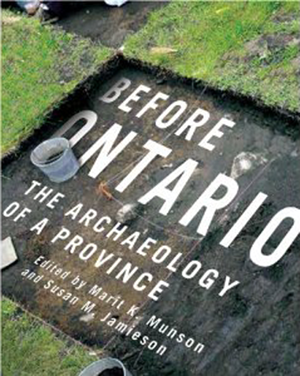Before Ontario: The Archaeology of a Province

Support Canada's History in other ways (more)
by Marit K. Munson and Susan M. Jamieson
McGill-Queen’s University Press, Montreal, 2013
260 pp., illus., $39.95 paperback
A double review with Underground New Brunswick: Stories of Archaeology
edited by Paul Erickson and Jonathan Fowler
Nimbus Publishing, Halifax, 2013
176 pp., illus., $24.95 paperback
From uncovering unexploded nineteenth-century bombs in Saint John to solving a “history mystery” involving a dugout canoe, Underground New Brunswick digs deep to tell a variety of stories about archaeological work in that province. Written by archaeology professionals and enthusiasts and edited by two professors at St. Mary’s University in Halifax, the book provides an engaging look at the challenges archaeologists face when doing their work.
For instance, in the case of a mysterious dugout canoe that washed up on a beach after a storm in 2002, the challenge was in obtaining an accurate age through tree-ring dating. The author describes in amusing detail how he and a graduate student awkwardly drilled into the rotting wood to obtain core samples as the artifact sat in a bath of preservative liquid. They eventually discovered that the white pine from which it was made had been cut down in 1557, making the canoe the oldest known watercraft in Atlantic Canada.
As the book notes, construction workers are often the first to come across archaeological artifacts. But rarely does it happen as dramatically as in 2009, when the Ordnance Building in Saint John was being renovated to attract commercial clients. While excavating, workers found an 1880s Royal Navy bomb. Construction stopped immediately as Defence Department experts rushed in with X-ray equipment and found thirty-three similar unexploded but potentially live bombs. Each was gently removed and safely detonated at CFB Gagetown, ending the archaeological bomb scare.
Readers will also learn about how archaeologists work with police to identify human remains. In one case in 2011, a map drawn by a psychic led searchers to the skull of a missing elderly man in a dense boggy forest in Miramichi. A forensic archaeology team determined that carnivores had scattered the remains and used knowledge of coyote feeding behaviour to recover the rest of the skeleton.
Before Ontario: The Archaeology of a Province also has various experts weighing in, this time on Ontario’s archaeological heritage. The first part of the book gives a broad overview of Ontario’s prehistory, while the second part deals with the different elements of archaeological investigation. For instance, there’s more to archaeology than pottery, stone tools, and bones. There is also the “archaeology of the invisible” — that is, paleoethnobotany, the study of ancient plants and how they were used by human beings. This sometimes involves the microscopic examination of pollens and spores that are invisible to the naked eye.
Before Ontario has more of a textbook-like feel. The stories it tells are broader and more general. It is, however, richly illustrated with graphs, sidebars, art, and high-quality photography. And it’s easy to use as a reference because of the way the material is organized.
— Nelle Oosterom (Read bio)
Nelle Oosterom is the Senior Editor of Canada's History magazine.